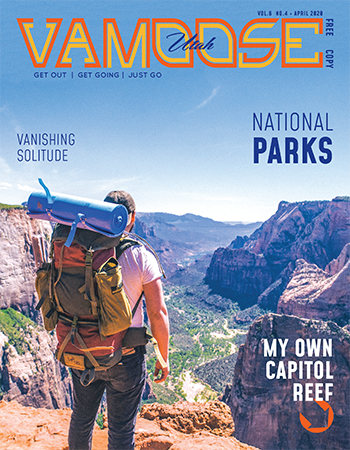With the proper gear, camping out under late winter’s blustery skies can be done in style and comfort.
Is camping during late winter/early spring better than summer? Some think so. With the right gear and a few warming tips, even newbies can learn the basics and enjoy the rewards of an off season campsite. Whether you’re setting up near the car, packing a snowmobile, mushing reindeer, or hauling gear with good ol’ human power, pack well to withstand chilly temperatures and stay dry, so you can forgo any cold-weather whining.
Our recommended gear list will keep you in check through the seasons, through rain, wind, sleet and snow. Even if you missed REI and end-of-summer sales, you can still find deals from local retailers and online wholesalers. Take our advice, and your camping trip may consist of more than shoveling snow.

Four-Season Shelters
Shelter is at the top of the list, and unless you plan to wait out the night in a snow cave laden with evergreen branches, your choice in a tent can make or break a trip. Go for a four-season tent for warmth and safety. Guides and pros have long trusted the North Face Mountain 25, and at a moderate price for a tent ($580), this 2-person option is nicely liveable. Double-wall tents are popular for winter, but they weigh more, so choose wisely. We also have a crush on the Hilleberg Nammatj high-altitude tent that pitches easily and is great for all locations. At $765, this 2-person tent is pricier but is lightweight and handles extreme weather conditions.
Sun Power
Most of us don’t totally unplug, even in the wild. Thus, portable solar-power options are your solution. For shorter trips, you may be able to do with a battery pack, but for longer hauls, a solar charger may be worth the extra weight. The Goal Zero (locally owned) Venture 30 solar kit ($170) is a rugged and well-made solar panel that will keep you charged. We also like BioLite Solar Panel 5 ($60). Its slim design weighs in at 12 ounces and has a 360-degree kickstand to capture rays wherever you like. It’s best to fully charge them before you leave, just in case. Cloud cover be damned, ain’t nothing going to stop us now! And you can catch a little solar power and some Vitamin D.

Function & Style
You can still enjoy style while utilizing effective layering and the right jacket. The essentials: A base layer, an insulating layer, a waterproof shell, a puffy jacket. With a combination of smart wool, fleece, Gore-Tex and down, you’ll laugh in the face of winter. But no cotton, no jeans and always sweat-wicking technology.
Canadian goose down is a plush choice for winter-specific jackets, and the Kensington Parka ($995) is top-drawer. For something more moderately priced, check out the Rab Neutrino Endurance Jacket ($375) with yummy goose-down insulation. We could do a whole review on down, insulated, soft-shell and hard-shell tested-tough jackets, including those for the winter intolerant that use rechargeable lithium ion batteries. But that’s just the start. You’ll also need, insulated, waterproof mountaineering boots like North Face Snowsquall ($130) and Western Mountaineering Down Booties ($100) Tip: fleece-lined waterproof socks are heaven!
Fire
While cold-weather camping keeps away the bugs and most other campers, it also makes it a challenge to find firewood for your cookstove or campfire. Alternatives like BioLite BioFuel pellets ($20) paired with the BioLite CampStove ($130) can truly make happy campers. The BioLite not only creates a smokeless fire for cooking meals and boiling water, it generates electricity so you can charge LED lights, mobile phones and other devices. Weighing 2.06 pounds, the BioLite has a tripod base, USB port and a flex-light side lamp.
If you’re not going for the traditional campfire that requires cutting wood above the snow line (a lot of work), you could opt for the folding FireBox Stove with a grill kit ($80). It’s an easy-to-assemble cook stove able to use wood, charcoal and other fuels.
Another option is to bring along your own bearded mountain man.

Nodding Off
Bedding is key! Choosing the right sleeping bag and pad to create ground separation will help retain your precious body heat. Not into Bear Grylls dirt beds? We recommend a sleeping bag rated to at least 10 degrees below the expected outdoor lows—especially if you are a “cold sleeper.” Try the Big Agnes Storm King ($380) down to zero degrees and 650-fill duck down. We like a bag with a little space, and this one has it. Being mummified is not on our list.
We also recommend the Marmot Trestles Bag with a solid synthetic fill ($112).
Next up is your sleeping pad. You’ll want one with heat-reflective material. Tip: Sleeping-bag ratings are made with the expectation that you will be using a sleeping pad. Retain heat with a pad that boasts a higher R value rating (measurement of material’s thermal resistance) Recommended: A self-inflating pad. You’ll thank us. Try the Therma Rest Pro Lite ($60) or the Therma Rest Ridge Rest ($20).
Keeping Extras
Our dream list shown here is just the tip of the proverbial iceberg. Space allowing, keep a supply of batteries (lithium is better in cold), gloves, hats, hand warmers, headlamps and outer shells. Also, consider extra eye protection from wind, cold and snow glare.
Camping weather in late winter/early spring is unpredictable. Being prepared means that your cool-weather outing won’t become a MacGyver-esque survival feat. Keep the warm beverages coming, stay hydrated and pack plenty of food.
Then, let sit back, warm as toast, taking in your frozen wonderland, listen to the silence and gaze upon the panorama of endless stars.



